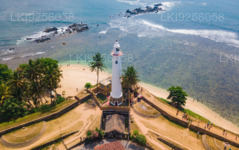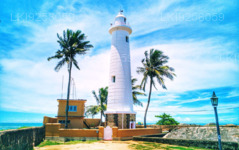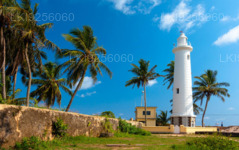
Galle City
Galle, a charming coastal city in Sri Lanka, boasts a rich history and vibrant culture. Its iconic Dutch Fort, a UNESCO World Heritage Site, stands as a testament to colonial influence. Explore pristine beaches, immerse in cultural festivals, and savor local cuisine amidst the old-world charm of Galle.
Galle Lighthouse
History
The Galle Lighthouse (also known as the Pointe de Galle Light) is Sri Lanka’s oldest light station, dating back to the mid-19th century and situated within the walls of the Galle Fort, a UNESCO World Heritage Site. The original Galle Lighthouse was established by the British in 1848 and was the first onshore lighthouse in the area, standing at 24.5 metres tall with a full view of the Galle Harbour. In 1934, a devastating fire destroyed the old lighthouse. This led to the construction of the current lighthouse in 1939, which stands taller than the original at 26.5 metres high and around 100 metres away from the site of its predecessor.
Changes Over the Years
The Galle Lighthouse is located about 4 kilometres away from Galle’s city centre, and has been built on the ramparts, approximately 6 metres above the level of the road, on a high point known as Point Utrecht Bastion. The original lighthouse contained a glass prism that sat within a mercury bath, which kept the lamp level and allowed it to rotate without undue friction. Lighthouse keepers were in charge of removing dirt and debris from the top of the bath, as well as periodically cleaning the liquid mercury, which exposed them daily to highly toxic levels of the metal. Today, however, the light within the Galle Lighthouse is fully automated, and the lighthouse keeper in charge need only climb up to ensure its upkeep.
About Galle District
Galle is a city situated on the southwestern tip of Sri Lanka, 119 km from Colombo.Galle is the best example of a fortified city built by Europeans in south and Southeast Asia, showing the interaction between European architectural styles and south Asian traditions. The Galle fort is a world heritage site and the largest remaining fortress in Asia built by European occupiers.
Galle is a sizeable town, by Sri Lankan standards, and has a population of 91,000, the majority of whom are of Sinhalese ethnicity. There is also a large Sri Lankan Moor minority, particularly in the fort area, which descend from Arab merchants that settled in the ancient port of Galle.
About Southern Province
The Southern Province of Sri Lanka is a small geographic area consisting of the districts of Galle, Matara and Hambantota. Subsistence farming and fishing is the main source of income for the vast majority of the people of this region.
Important landmarks of the Southern Province include the wildlife sanctuaries of the Yala and Udawalawe National Parks, the holy city of Kataragama, and the ancient cities of Tissamaharama, Kirinda and Galle. (Although Galle is an ancient city, almost nothing survives from before the Portuguese invasion.) During the Portuguese period there were two famous Sinhalese poets called Andare who was from Dickwella and Gajaman Nona who was from Denipitiya in Matara District, composing poems on common man.






















